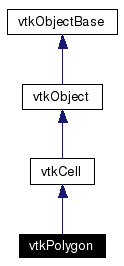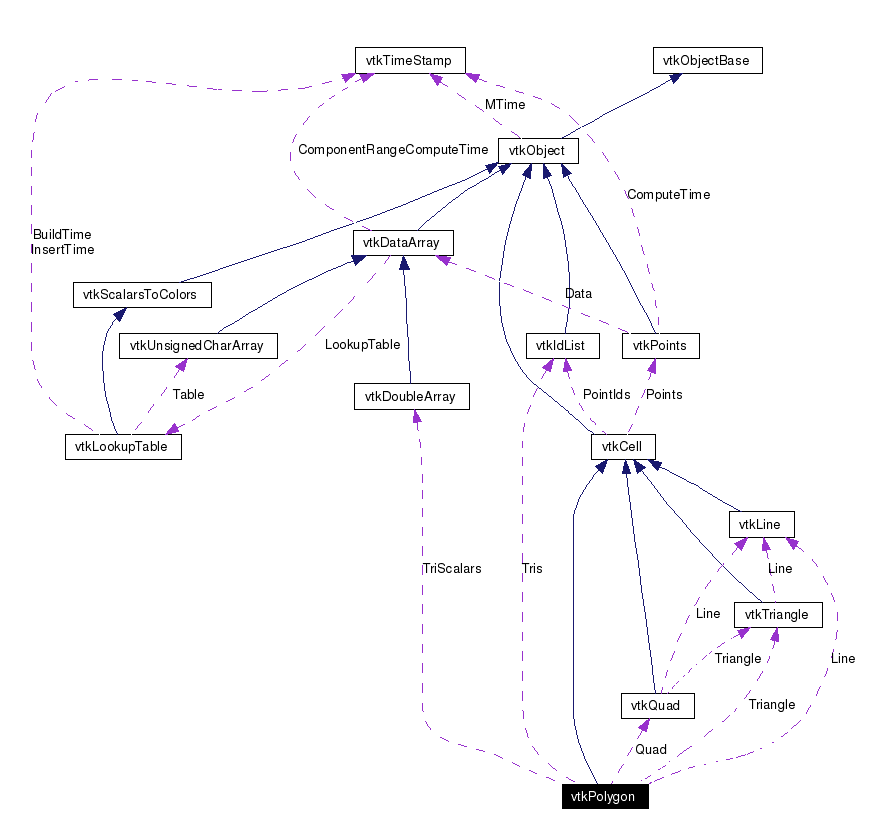
#include <vtkPolygon.h>
Inheritance diagram for vtkPolygon:


vtkPolygon is a concrete implementation of vtkCell to represent a 2D n-sided polygon. The polygons cannot have any internal holes, and cannot self-intersect. Define the polygon with n-points ordered in the counter- clockwise direction; do not repeat the last point.
Definition at line 41 of file vtkPolygon.h.
| int | Triangulate (vtkIdList *outTris) |
| static int | IntersectPolygonWithPolygon (int npts, double *pts, double bounds[6], int npts2, double *pts2, double bounds2[3], double tol, double x[3]) |
Public Types | |
| typedef vtkCell | Superclass |
Public Member Functions | |
| virtual const char * | GetClassName () |
| virtual int | IsA (const char *type) |
| void | PrintSelf (ostream &os, vtkIndent indent) |
| int | GetCellType () |
| int | GetCellDimension () |
| int | GetNumberOfEdges () |
| int | GetNumberOfFaces () |
| vtkCell * | GetEdge (int edgeId) |
| vtkCell * | GetFace (int) |
| int | CellBoundary (int subId, double pcoords[3], vtkIdList *pts) |
| void | Contour (double value, vtkDataArray *cellScalars, vtkPointLocator *locator, vtkCellArray *verts, vtkCellArray *lines, vtkCellArray *polys, vtkPointData *inPd, vtkPointData *outPd, vtkCellData *inCd, vtkIdType cellId, vtkCellData *outCd) |
| void | Clip (double value, vtkDataArray *cellScalars, vtkPointLocator *locator, vtkCellArray *tris, vtkPointData *inPd, vtkPointData *outPd, vtkCellData *inCd, vtkIdType cellId, vtkCellData *outCd, int insideOut) |
| int | EvaluatePosition (double x[3], double *closestPoint, int &subId, double pcoords[3], double &dist2, double *weights) |
| void | EvaluateLocation (int &subId, double pcoords[3], double x[3], double *weights) |
| int | IntersectWithLine (double p1[3], double p2[3], double tol, double &t, double x[3], double pcoords[3], int &subId) |
| int | Triangulate (int index, vtkIdList *ptIds, vtkPoints *pts) |
| void | Derivatives (int subId, double pcoords[3], double *values, int dim, double *derivs) |
| int | IsPrimaryCell () |
| void | ComputeWeights (double x[3], double *weights) |
| int | ParameterizePolygon (double p0[3], double p10[3], double &l10, double p20[3], double &l20, double n[3]) |
Static Public Member Functions | |
| static vtkPolygon * | New () |
| static int | IsTypeOf (const char *type) |
| static vtkPolygon * | SafeDownCast (vtkObject *o) |
| static void | ComputeNormal (int numPts, double *pts, double n[3]) |
| static void | ComputeNormal (vtkPoints *p, int numPts, vtkIdType *pts, double n[3]) |
| static void | ComputeNormal (vtkPoints *p, double n[3]) |
| static int | PointInPolygon (double x[3], int numPts, double *pts, double bounds[6], double n[3]) |
Protected Member Functions | |
| vtkPolygon () | |
| ~vtkPolygon () | |
| int | EarCutTriangulation () |
Protected Attributes | |
| double | Tolerance |
| int | SuccessfulTriangulation |
| double | Normal [3] |
| vtkIdList * | Tris |
| vtkTriangle * | Triangle |
| vtkQuad * | Quad |
| vtkDoubleArray * | TriScalars |
| vtkLine * | Line |
|
|
Reimplemented from vtkCell. Definition at line 45 of file vtkPolygon.h. |
|
|
|
|
|
|
|
|
Create an object with Debug turned off, modified time initialized to zero, and reference counting on. Reimplemented from vtkObject. |
|
|
Reimplemented from vtkCell. |
|
|
Return 1 if this class type is the same type of (or a subclass of) the named class. Returns 0 otherwise. This method works in combination with vtkTypeRevisionMacro found in vtkSetGet.h. Reimplemented from vtkCell. |
|
|
Return 1 if this class is the same type of (or a subclass of) the named class. Returns 0 otherwise. This method works in combination with vtkTypeRevisionMacro found in vtkSetGet.h. Reimplemented from vtkCell. |
|
|
Reimplemented from vtkCell. |
|
||||||||||||
|
Methods invoked by print to print information about the object including superclasses. Typically not called by the user (use Print() instead) but used in the hierarchical print process to combine the output of several classes. Reimplemented from vtkCell. |
|
|
See the vtkCell API for descriptions of these methods. Implements vtkCell. Definition at line 50 of file vtkPolygon.h. References VTK_POLYGON. |
|
|
Return the topological dimensional of the cell (0,1,2, or 3). Implements vtkCell. Definition at line 51 of file vtkPolygon.h. |
|
|
Return the number of edges in the cell. Implements vtkCell. Definition at line 52 of file vtkPolygon.h. References vtkCell::GetNumberOfPoints(). |
|
|
Return the number of faces in the cell. Implements vtkCell. Definition at line 53 of file vtkPolygon.h. |
|
|
Return the edge cell from the edgeId of the cell. Implements vtkCell. |
|
|
Return the face cell from the faceId of the cell. Implements vtkCell. Definition at line 55 of file vtkPolygon.h. |
|
||||||||||||||||
|
Given parametric coordinates of a point, return the closest cell boundary, and whether the point is inside or outside of the cell. The cell boundary is defined by a list of points (pts) that specify a face (3D cell), edge (2D cell), or vertex (1D cell). If the return value of the method is != 0, then the point is inside the cell. Implements vtkCell. |
|
||||||||||||||||||||||||||||||||||||||||||||||||
|
Generate contouring primitives. The scalar list cellScalars are scalar values at each cell point. The point locator is essentially a points list that merges points as they are inserted (i.e., prevents duplicates). Contouring primitives can be vertices, lines, or polygons. It is possible to interpolate point data along the edge by providing input and output point data - if outPd is NULL, then no interpolation is performed. Also, if the output cell data is non-NULL, the cell data from the contoured cell is passed to the generated contouring primitives. (Note: the CopyAllocate() method must be invoked on both the output cell and point data. The cellId refers to the cell from which the cell data is copied.) Implements vtkCell. |
|
||||||||||||||||||||||||||||||||||||||||||||
|
Cut (or clip) the cell based on the input cellScalars and the specified value. The output of the clip operation will be one or more cells of the same topological dimension as the original cell. The flag insideOut controls what part of the cell is considered inside - normally cell points whose scalar value is greater than "value" are considered inside. If insideOut is on, this is reversed. Also, if the output cell data is non-NULL, the cell data from the clipped cell is passed to the generated contouring primitives. (Note: the CopyAllocate() method must be invoked on both the output cell and point data. The cellId refers to the cell from which the cell data is copied.) Implements vtkCell. |
|
||||||||||||||||||||||||||||
|
Given a point x[3] return inside(=1) or outside(=0) cell; evaluate parametric coordinates, sub-cell id (!=0 only if cell is composite), distance squared of point x[3] to cell (in particular, the sub-cell indicated), closest point on cell to x[3] (unless closestPoint is null, in which case, the closest point and dist2 are not found), and interpolation weights in cell. (The number of weights is equal to the number of points defining the cell). Note: on rare occasions a -1 is returned from the method. This means that numerical error has occurred and all data returned from this method should be ignored. Also, inside/outside is determine parametrically. That is, a point is inside if it satisfies parametric limits. This can cause problems for cells of topological dimension 2 or less, since a point in 3D can project onto the cell within parametric limits but be "far" from the cell. Thus the value dist2 may be checked to determine true in/out. Implements vtkCell. |
|
||||||||||||||||||||
|
Determine global coordinate (x[3]) from subId and parametric coordinates. Also returns interpolation weights. (The number of weights is equal to the number of points in the cell.) Implements vtkCell. |
|
||||||||||||||||||||||||||||||||
|
Intersect with a ray. Return parametric coordinates (both line and cell) and global intersection coordinates, given ray definition and tolerance. The method returns non-zero value if intersection occurs. Implements vtkCell. |
|
||||||||||||||||
|
Generate simplices of proper dimension. If cell is 3D, tetrahedron are generated; if 2D triangles; if 1D lines; if 0D points. The form of the output is a sequence of points, each n+1 points (where n is topological cell dimension) defining a simplex. The index is a parameter that controls which triangulation to use (if more than one is possible). If numerical degeneracy encountered, 0 is returned, otherwise 1 is returned. This method does not insert new points: all the points that define the simplices are the points that define the cell. Implements vtkCell. |
|
||||||||||||||||||||||||
|
Compute derivatives given cell subId and parametric coordinates. The values array is a series of data value(s) at the cell points. There is a one-to-one correspondence between cell point and data value(s). Dim is the number of data values per cell point. Derivs are derivatives in the x-y-z coordinate directions for each data value. Thus, if computing derivatives for a scalar function in a hexahedron, dim=1, 8 values are supplied, and 3 deriv values are returned (i.e., derivatives in x-y-z directions). On the other hand, if computing derivatives of velocity (vx,vy,vz) dim=3, 24 values are supplied ((vx,vy,vz)1, (vx,vy,vz)2, ....()8), and 9 deriv values are returned ((d(vx)/dx),(d(vx)/dy),(d(vx)/dz), (d(vy)/dx),(d(vy)/dy), (d(vy)/dz), (d(vz)/dx),(d(vz)/dy),(d(vz)/dz)). Implements vtkCell. |
|
|
Return whether this cell type has a fixed topology or whether the topology varies depending on the data (e.g., vtkConvexPointSet). This compares to composite cells that are typically composed of primary cells (e.g., a triangle strip composite cell is made up of triangle primary cells). Reimplemented from vtkCell. Definition at line 77 of file vtkPolygon.h. |
|
||||||||||||||||||||
|
Polygon specific methods. |
|
||||||||||||
|
Polygon specific methods. |
|
||||||||||||||||
|
Compute the polygon normal from an array of points. This version assumes that the polygon is convex, and looks for the first valid normal. |
|
||||||||||||
|
Compute interpolation weights using 1/r**2 normalized sum. |
|
||||||||||||||||||||||||||||
|
Create a local s-t coordinate system for a polygon. The point p0 is the origin of the local system, p10 is s-axis vector, and p20 is the t-axis vector. (These are expressed in the modeling coordinate system and are vectors of dimension [3].) The values l20 and l20 are the lengths of the vectors p10 and p20, and n is the polygon normal. |
|
||||||||||||||||||||||||
|
Determine whether point is inside polygon. Function uses ray-casting to determine if point is inside polygon. Works for arbitrary polygon shape (e.g., non-convex). Returns 0 if point is not in polygon; 1 if it is. Can also return -1 to indicate degenerate polygon. |
|
|
Triangulate this polygon. The user must provide the vtkIdList outTris. On output, the outTris list contains the ids of the points defining the triangulation. The ids are ordered into groups of three: each three-group defines one triangle. |
|
||||||||||||||||||||||||||||||||||||
|
Method intersects two polygons. You must supply the number of points and point coordinates (npts, *pts) and the bounding box (bounds) of the two polygons. Also supply a tolerance squared for controlling error. The method returns 1 if there is an intersection, and 0 if not. A single point of intersection x[3] is also returned if there is an intersection. |
|
|
A fast triangulation method. Uses recursive divide and conquer based on plane splitting to reduce loop into triangles. The cell (e.g., triangle) is presumed properly initialized (i.e., Points and PointIds). |
|
|
Definition at line 139 of file vtkPolygon.h. |
|
|
Definition at line 140 of file vtkPolygon.h. |
|
|
Definition at line 141 of file vtkPolygon.h. |
|
|
Definition at line 142 of file vtkPolygon.h. |
|
|
Definition at line 143 of file vtkPolygon.h. |
|
|
Definition at line 144 of file vtkPolygon.h. |
|
|
Definition at line 145 of file vtkPolygon.h. |
|
|
Definition at line 146 of file vtkPolygon.h. |
 1.4.3-20050530
1.4.3-20050530